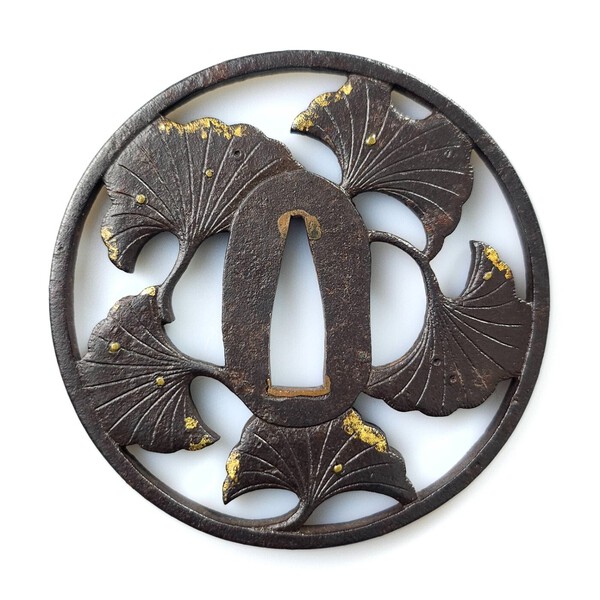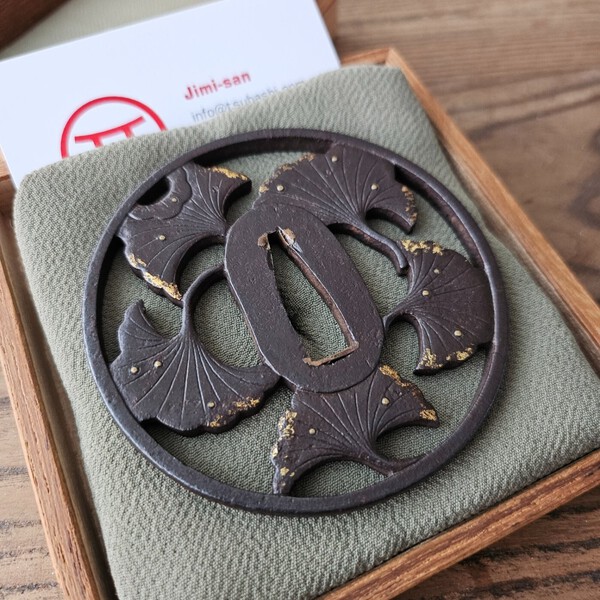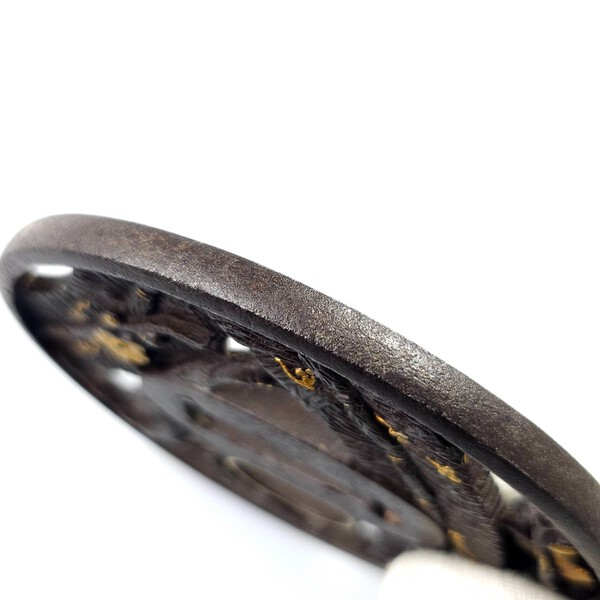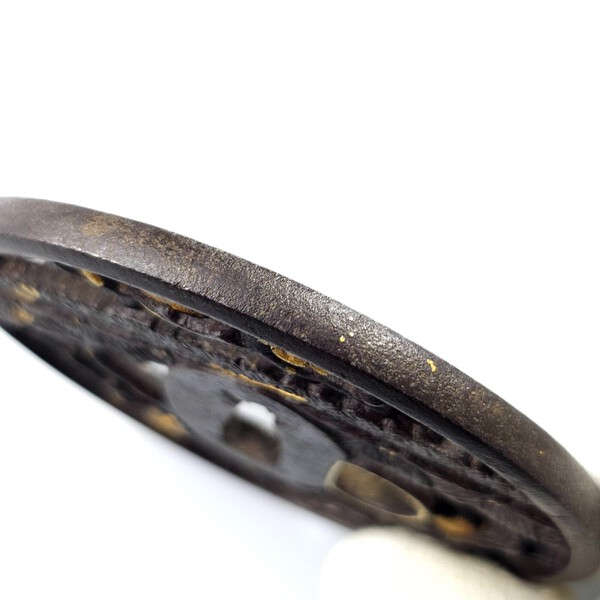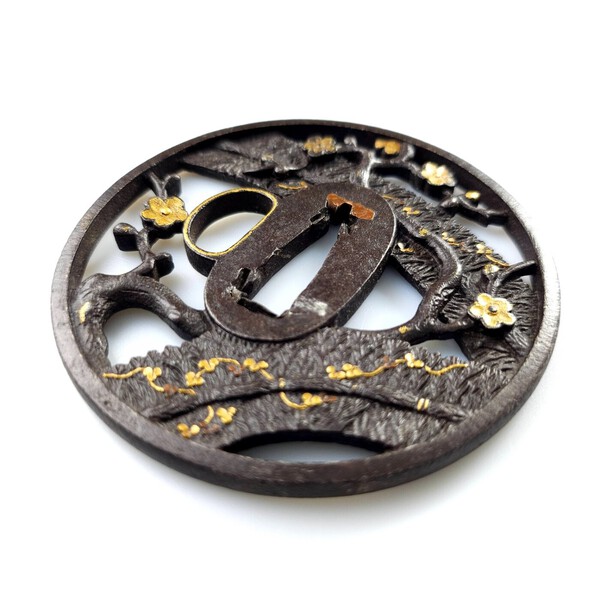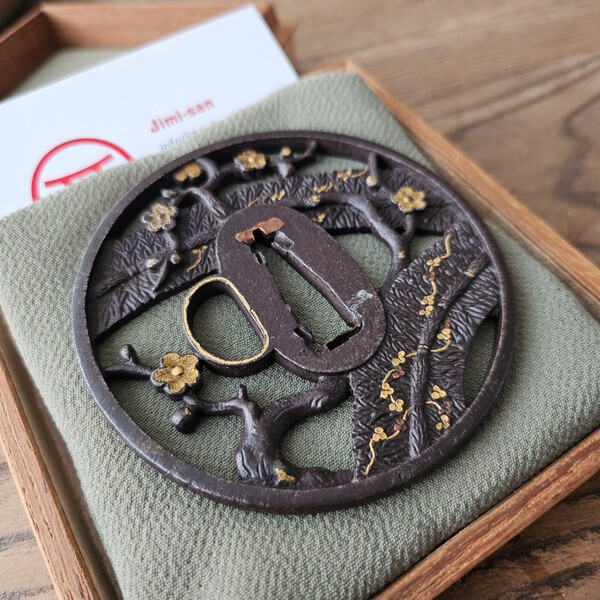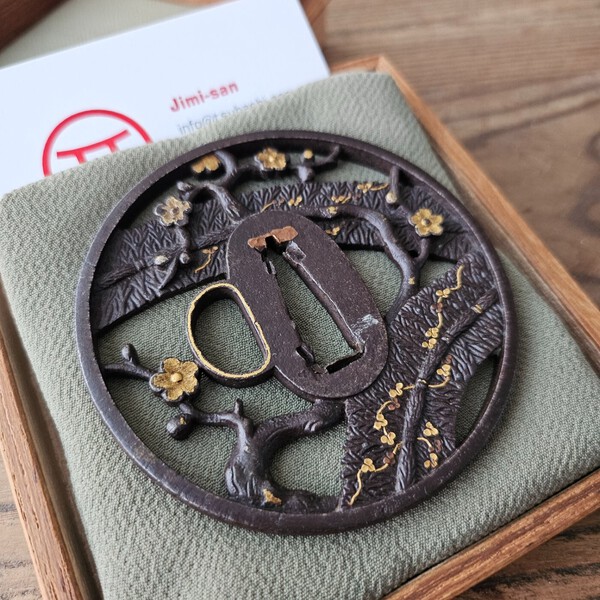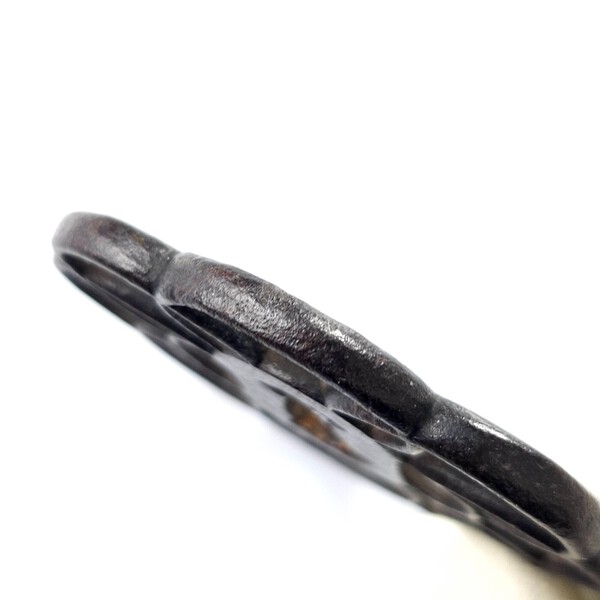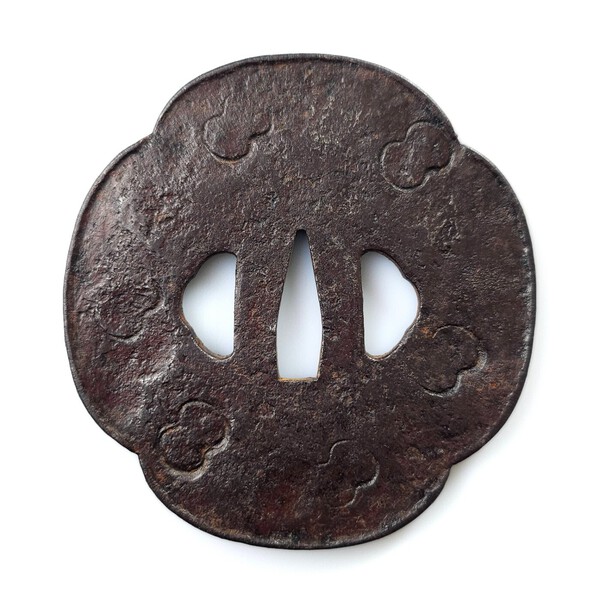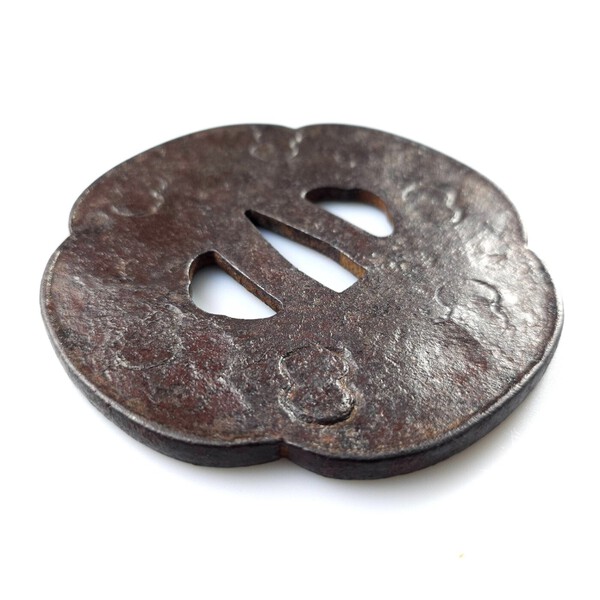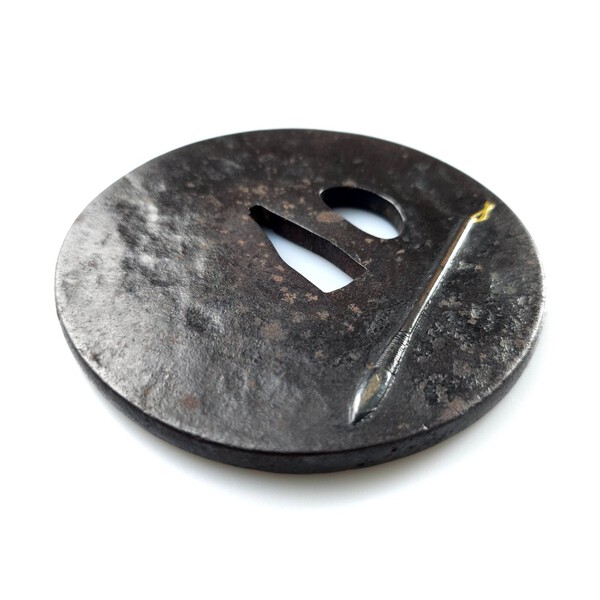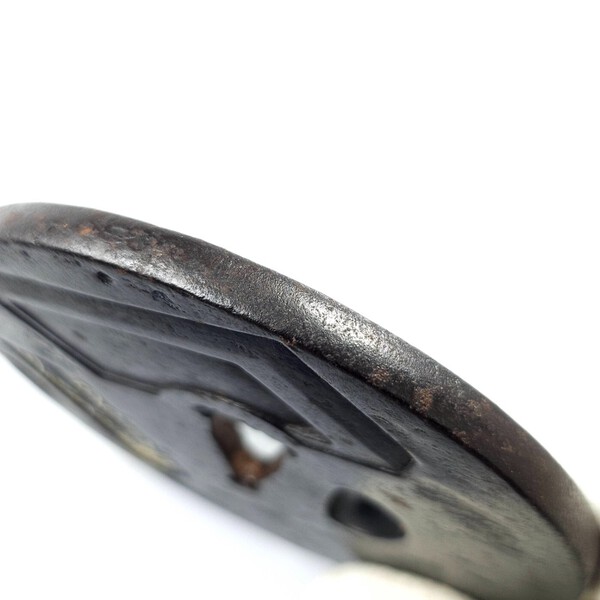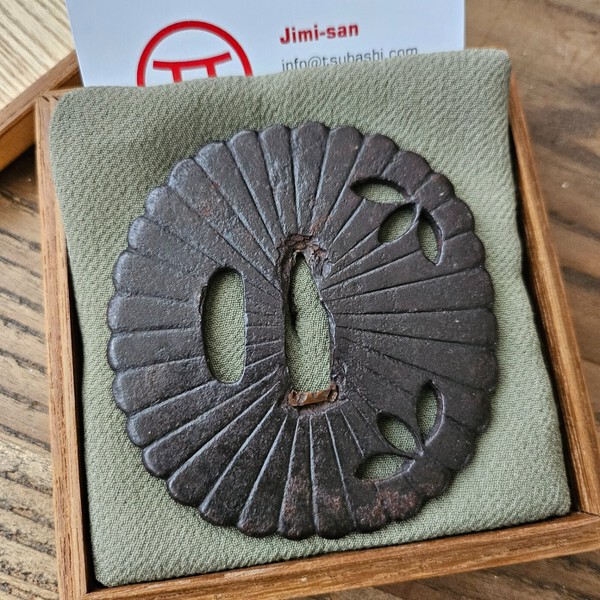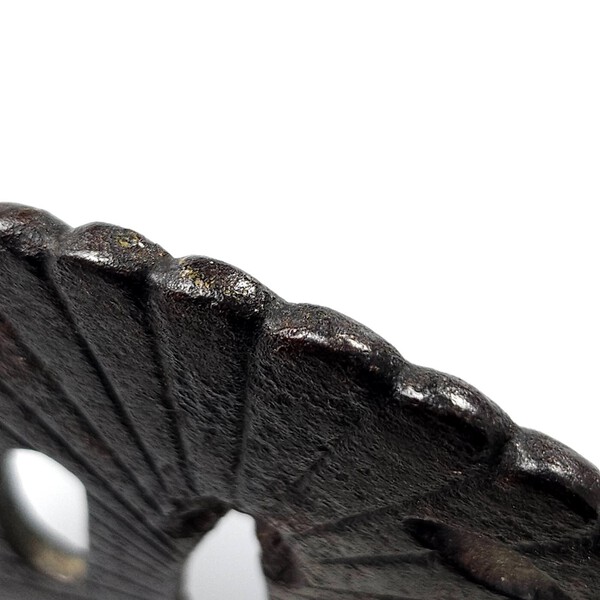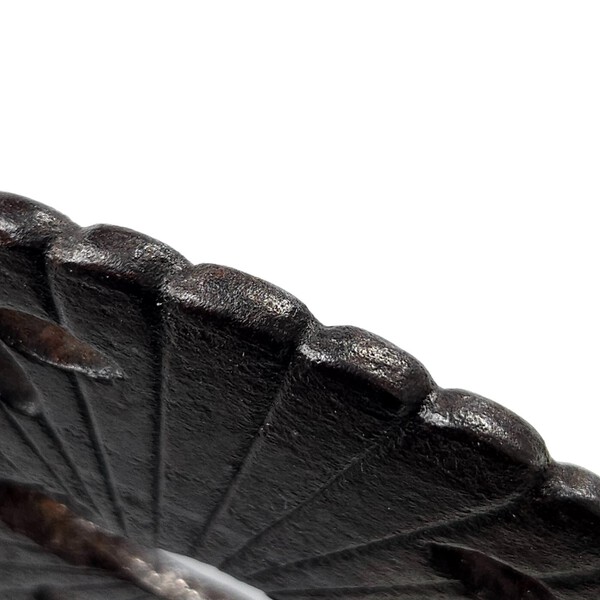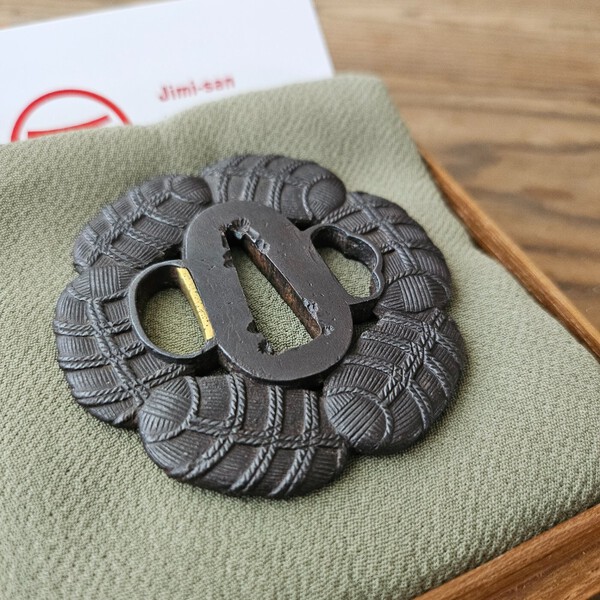-
Posts
406 -
Joined
-
Last visited
-
Days Won
2
Content Type
Profiles
Forums
Events
Store
Downloads
Gallery
Everything posted by Jorgensen
-
@Matsunoki There is a tsuba very, very similar to the one you linked to on ebay at Powerhouse Collection here: https://collection.p...com.au/object/182953 Here they suggest the tsuba to Omi style... That supposeit is Omi branch / Omi Hikone they refer to... Interesting! POWERHOUSE TSUBA: TSUBA ON EBAY: MY TSUBA:
-
@Matsunoki Thank you very much for the link. It does not work anymore, however I did see it and that tsuba share many similarities. More than most others I have seen indeed. But... I did have thoughts in direction of Soten/Hikone school at an early stage in my considerations. However, the lack of more defined mimi, nakago- and hitsu-ana, representation of pines or sukashi at all on my tsuba made me conclude this was not the case. Also the presence of nanako and especially the gold seal on my tsuba supported my idea of not being Soten/Hikone school. I cannot remember ever have seen a Soten/Hikone tsuba with gold seal? My main ideas of school have been working around Tesugendo, Mino or Nara/Hamano... But as there are no rules without exceptions Hikone could absolutely be an option. If any have other ideas, I am all ears
-
@Jake6500 Thank you for your comments Jake. I am sure its depicting Guan Yu as well. I actually do have a kozuka with same image shown at last picture. Aizu Shoami have crossed my mind too, but what confuses me is that I cannot remember I have seen any Aizu Shoami works with gold seal. As for the gold seal, the seal on my tsuba looks to be of more "compact" or "beefy" in style of those on pictures inserted below: rather than seals with fine thin lines like this: I have considered Tetsugendo school, as they often used gold seal and same shape/style, but not sure it matches quality.... it could be anything...
-
@Iaido dude Stephen, thats a great idea! I think that could even be possible to make this in staggered layers perhaps. Doing so will make it possible to have quite a lot of tsubas fit into one single travel case?
-
Thanks for your comments about the box. I should have mentioned that the box itself I have not made, but buy as finished product. I should have been more clear about that. The box is made of piano lacquered stained pine wood. The inside I have made from high-quality EVA foam and thin self-adhessive soft velour material. EVA foam is a very durable material, easy to work with and the velour material is made of cotton and are not harmful to tsuba. Actually none of the stuff inside box is glued together or to the box, just sits tight and can easily be removed (but not too easy of course). The reason I want boxes with close mechanism or lock is because I want to built in the padding in the lid, and it will be very difficult to make it that precise on normal box and still have the lid close well. Also, on a normal box one will still need to use a rubber band to secure the box during transport. My goal is to make it as simple and easy as possible and remove everything unnecessary – including the peg. Its not very traditional, even that I try to hold on to some traditional traits. I have attached a couple pictures with some more boxes I have experiemented with. On one of the inserts I have tried to make a little “half-circle” so its easy to take out tsuba, although I don’t like the result very much and is unneccesary as its very easy to take out the tsuba from the inserts anyways. Btw... The piano laquered box comes with an outer white cardboard box with lid and I find it quite nice to have the possibility to add some info here and for the storage of the tsuba in general. .
-
A Myochin Mokume Tachibana tsuba Asking price: $475 (or best offer) Buy or make offer here: https://tsubashi.com...ume-tachibana-tsuba/ Description: Iron, marugata, mokume (wood-grain) pattern on the base, with symmetrical sukashi designs of Tachibana. The mokume iron base is distinctive, and hints at the Myōchin school, or perhaps one of the metalworkers from Sado Island (Sashū). The design looks to be a tachibana (citrus) flower, often used in family crests. Two hitsu ana formed by the openwork of the flowers. Mid Edo. Note: Although its school is hard to pinpoint. I think Myochin is the right attribution. I can see that wood-grain with sukashi is also a hallmark of the smiths working on Sado Island (who themselves were probably influenced by Myochin). Mei/signature: Mumei School/province: Myochin (or possibly Sado Island) Period/age: Edo Measures: 6.80 cm x 6.55 cm x 0.50 cm Certificate: No Included: NO kiri box included
-
A nice Bushu Ito school tsuba for sale Asking price: $425 (or best offer) Iron, marugata, image of cherry blossoms on floating rafts (hana ikada). Bushū Itō school. The image is one which evokes the harvesting of wood from the forests around Kyoto, bundling the logs into rafts, and floating them down the Kamo River to be sold in Osaka. In the springtime, the cherry blossoms would fall onto the logs, and the site of the logs floating on the river, decorated with Kyoto’s cherry blossoms would delight people along the riverbank. Highlights in gold inlay. Two hitsu-ana (one plugged with shakudō). Mid Edo era. Mei/signature: Mumei School/province: Bushu-Ito Period/age: Edo Measures: 7.30 cm x 6.80 cm x 0.45 cm Certificate: No Included: NO kiri box included Buy or make offer here: https://tsubashi.com...hu-ito-school-tsuba/ Questions? - e-mail me: info@tsubashi.com
-
NOTE: As I wish to make deals as honest and faithful as possible, I would like to add to above that Ko-Tosho / Tosho tsuba are not the area where I am most experienced and you should judge carefully from pictures and video and decide for yourself whether this tsuba being Ko-Tosho, Tosho or even a edo piece made in Tosho style. I felt convinced about this one being Ko-Tosho when I compared to this one (among others): https://tsuba.info/product/ko-tosho-ume-2/ Another correction is that its not plum, but cherry blossoms. Thanks to the members that notified me on that typo.
-
Ko-Tosho tsuba for sale - asking price $850 Ko-Tosho (swordsmith) Tsuba. Iron, marugata, slightly convex (goishi-gata), with image of ume (plum), snowflake, and hat in sukashi openwork. It is ubu without hitsu ana dating back to Muromachi period. The image depicted is one representing the Noh play “Hachi-no-ki”, which tells of the sacrifice of an innkeeper who cut down his treasured potted trees so that he could put them in the fire to provide warmth for a traveling monk. The monk was actually a lord in disguise, who eventually repaid the innkeeper’s kindness by granting him some lands. A very tasteful tsuba, exemplifying the wabi-sabi aesthetic of restrained elegance. Mei/signature: Mumei School/province: Ko-Tosho (swordsmith tsuba) Period/age: Muromachi period Measures: 7.65 cm x 7.25 cm x 0.3,5 cm (x 0.25 cm at mimi) Certificate: No Included: NO kiri box included Buy it directly here: https://tsubashi.com...sho-muramachi-tsuba/ Questions? - e-mail me: info@tsubashi.com
-
The other day I did a quick test making a custom "luxury" tsuba box. The purpose with the box is, besides containing a tsuba of course, to skip the need for a pillow, as the padding in the lid keeps the tsuba in place. Box have soft open/close hinges and made so it will stay closed until you lightly “force” the lid open and hinges is designed to ensure lid stays open until you close it again... There is room for improvements, but this is the result so far...
- 7 replies
-
- 14
-

-

-
I took a chance and bought this tsuba cheaply on a doubtful online trading website (seller was a small french botique), only having those poor very dirty (before) pictures below to judge from. However it cleaned up quite well, unfortunately the seal was too corroded to be able to read. I have searched through books, online and so on, but cant find anything that leads me in a more definitive direction of school or maker... So any help is very much appreciated - anybody having ideas on school/maker? I believe image is of Guan Yu (Kwan Yu) holding his long beard while reading, in the background his Kwan Dao. Tsuba have signature with gold seal/kaao, which unfortunately is impossible to read. Kwan Yu (or Kwan Kung), also known as Guan Yu or Kuan Yu, is a legendary Chinese general from the Three Kingdoms period and is often associated with qualities like bravery, loyalty, and protection. Measures: 6.8 cm x 7.4 cm x 0.50 cm Weight: 135g BEFORE & AFTER PICTURES: VIDEO:
-
Thanks for sharing. Its a very cute one, similar design and hitsu-ana shape is similar too. I guess it would be katana or wakizashi plus tanto daisho in that case
-
Five ginko leaves in sukashi tsuba $545 (offers welcome) More info: https://tsubashi.com...es-in-sukashi-tsuba/ Iron, marugata, image of five ginko leaves in sukashi, with gold inlay (nunome zōgan) on the leaf edges, and gold “tenzōgan” dots representing dew drops on the leaves. Possibly Bushū school, but the nunome-zōgan and the ten-zōgan could point to an earlier school such as Kyō-Shōami. Two hitsu-ana, both artfully defined by the voids created by the leaf stems rather than a hard border as is commonly seen on tsuba. An interesting piece that will nicely compliment any collection. Mei/signature: Mumei School/province: Possibly Bushū or Kyō-Shōami Period/age: Edo Measures: 8.25 cm x 8.25 cm x 0.50 cm Certificate: No Included: NO kiri box included
-
Plum-themed tsuba with gold nunome-zōgan $545 (offers welcome) More info: https://tsubashi.com...es-in-sukashi-tsuba/ Iron, marugata, image of five ginko leaves in sukashi, with gold inlay (nunome zōgan) on the leaf edges, and gold “tenzōgan” dots representing dew drops on the leaves. Possibly Bushū school, but the nunome-zōgan and the ten-zōgan could point to an earlier school such as Kyō-Shōami. Two hitsu-ana, both artfully defined by the voids created by the leaf stems rather than a hard border as is commonly seen on tsuba. An interesting piece that will nicely compliment any collection. Mei/signature: Mumei School/province: Possibly Bushū or Kyō-Shōami Period/age: Edo Measures: 8.25 cm x 8.25 cm x 0.50 cm Certificate: No Included: NO kiri box included
-
- 1
-

-
Early eight-lobed Shoami school tsuba $845 (offers welcome) More info: https://tsubashi.com/.../early-eight-lobed-shoami-school.../ Iron, eight-lobed mokkōgata, with eight interlocking rings possibly symbolizing the Noble Eightfold Path of righteousness of Buddhism. A deceptively intricate design, yet with a rustic feeling in the iron from the early Shōami school. Two hitsu-ana. This tsuba is very well-balanced, and I think the hitsu-ana are nicely incorporated, and overall it must be difficult to make such a well-balanced eight ring tsuba with two hitsu ana. A quality tsuba in good condition. Mei/signature: Mumei School/province: Shōami Period/age: Early Edo (or possibly Muromachi) Measures: 7.75 cm x 7.65 cm x 0.50 cm Certificate: No Included: NO kiri box included
-
A large Tenpo tsuba (+9 cm) $275 (offers welcome) More info: https://tsubashi.com/product/a-large-tenpo-tsuba/ Iron, mokkōgata, hammer-patterned base with slightly raised rim, embossed on front and back with geometric designs. Two hitsu-ana, both in the shape of kōgai. Mei/signature: Mumei School/province: Tenpō Period/age: Edo Measures: 9.50 cm x 9.05 cm x 0.35 cm (0.55 cm at mimi) Certificate: No Included: NO kiri box included
-
A big Kotobuki tsuba (+9 cm) $545 (offers welcome) More info: https://tsubashi.com/product/a-big-kotobuki-tsuba/ Iron, marugata, hammer-patterned surface with image of ink and inkstone on the front, and ink brush on the back. The design on the ink stick looks to be a stylized kanji for 壽 (kotobuki – long life), and is done in gold inlay. Likewise, the brush on the reverse is also decorated with colored metal inlays. The theme reveals the cultured world of the samurai, who ideally should strive to be as proficient in letters as he should be in the martial arts. Condition of this tsuba is very good and is very heavyIt has little stylistic surprises like the word “Kotobuki” which is almost hidden in the design on the ink, and the way the seppa-dai covers the inkstone in a way that gives a feeling of depth. The tsuba looks black and a bit glossy, as if it were a kind of ink stick itself. Mei/signature: Mumei School/province: Unknown Period/age: Edo Measures: 9.05 cm x 8.75 cm x 0.60 cm 249 grams Certificate: No Included: NO kiri box included
-
- 2
-

-
A nice big Muromachi Saotome tsuba $795 More info: https://tsubashi.com...machi-saotome-tsuba/ Iron, kikkagata tsuba in the shape of a 32 petalled-chrysanthemum, with two sukashi on the right side, and a hitsu-ana on the left. This tsuba is most likely Saotome school, even that Myochin is a possibility, but I believe Saotome is correct. This tsuba is very old and probably from Muromachi era. Its a quite big tsuba and very nice condition for its age. Mei/signature: Mumei School/province: Saotome Period/age: Muromachi Measures: 8.30 cm x 7.80 cm x 0.30 cm Certificate: No Included: NO kiri box included
-
Charming tsuba of 3 Eggplants Asking price: $545 (or best offer) More info: https://tsubashi.com...suba-of-3-eggplants/ Iron, marugata, three Japanese eggplants (nasu), with two in positive sukashi and one in negative sukashi. The three nasu are most likely an allusion to the three New Year’s good luck omens, which are: Mt. Fuji, a falcon, and an eggplant. It is said that you will have good luck when you dream of these auspicious items on New Year’s day. The exact reason that eggplants (nasu) are considered good luck unknown. It could be that they relate to the Shogun Tokugawa Ieyasu’s fondness for eggplant. It could also be related to the word for eggplant (nasu) being a homonym for “to become”, and that this item represents attaining some desired achievement. Whatever the reason, this tsuba is particularly charming due to the use of positive and negative sukashi, and because of its pristine condition. Chōshū or Bushū school. Mei/signature: Mumei School/province: Chōshū or Bushū school Period/age: Edo Measures: 6.90 cm x 6.60 cm x 0.60 cm Certificate: No Included: NO kiri box included
-
- 1
-

-
Tsuba of six bales of rice arranged in a circle Asking price: $345 (or best offer) More info: https://tsubashi.com...rranged-in-a-circle/ Iron, kawarigata tsuba in the image of six bales of rice arranged in a circle. Rice was the unit of measurement of great wealth, so the design of this tsuba (and the many like it) is intended to convey the idea of wealth and prosperity – or the hope of such. The initial design may have come from Chōshū, but it was copied by many artists spanning many generations. Two hitsu-ana. This tsuba is in very good condition. Mei/signature: Mumei School/province: Possibly Chōshū Period/age: Edo Measures: 6.85 cm x 6.50 cm x 0.60 cm Certificate: No Included: NO kiri box included
-
- 2
-

-
@Soshin Thanks for your opinion, much appreciated. I believe you are right and also believes this tsuba are not very old, however the quite nice patina and the obvious signs that it surely do have some age, combined with the thickness of barely 2 mm and the knowledge that this tsuba comes from a collection where it have been within for the at least 35-50 years was confusing me, despite for the many years I have been collecting myself. Although I think its a strange and charming little fella.
-
Hello, I have this tsuba that I find very unusual and stumbles me some bit. It looks to have some age to it, but on the other side... copy?... modern made? Your opinions will be appreciated. Measures are 8.35 cm x 8.05 cm x 0,20 cm.
-
I was contacted by a member here, whom informed be that one of my tsuba is represented on this website and tried to fraud him. Luckily it didnt happen. The website seems to copy nihonto/tosogu from ebay auctions. This website is NOT legitimate! Link to website: https://2024onlineshop.ru/
















